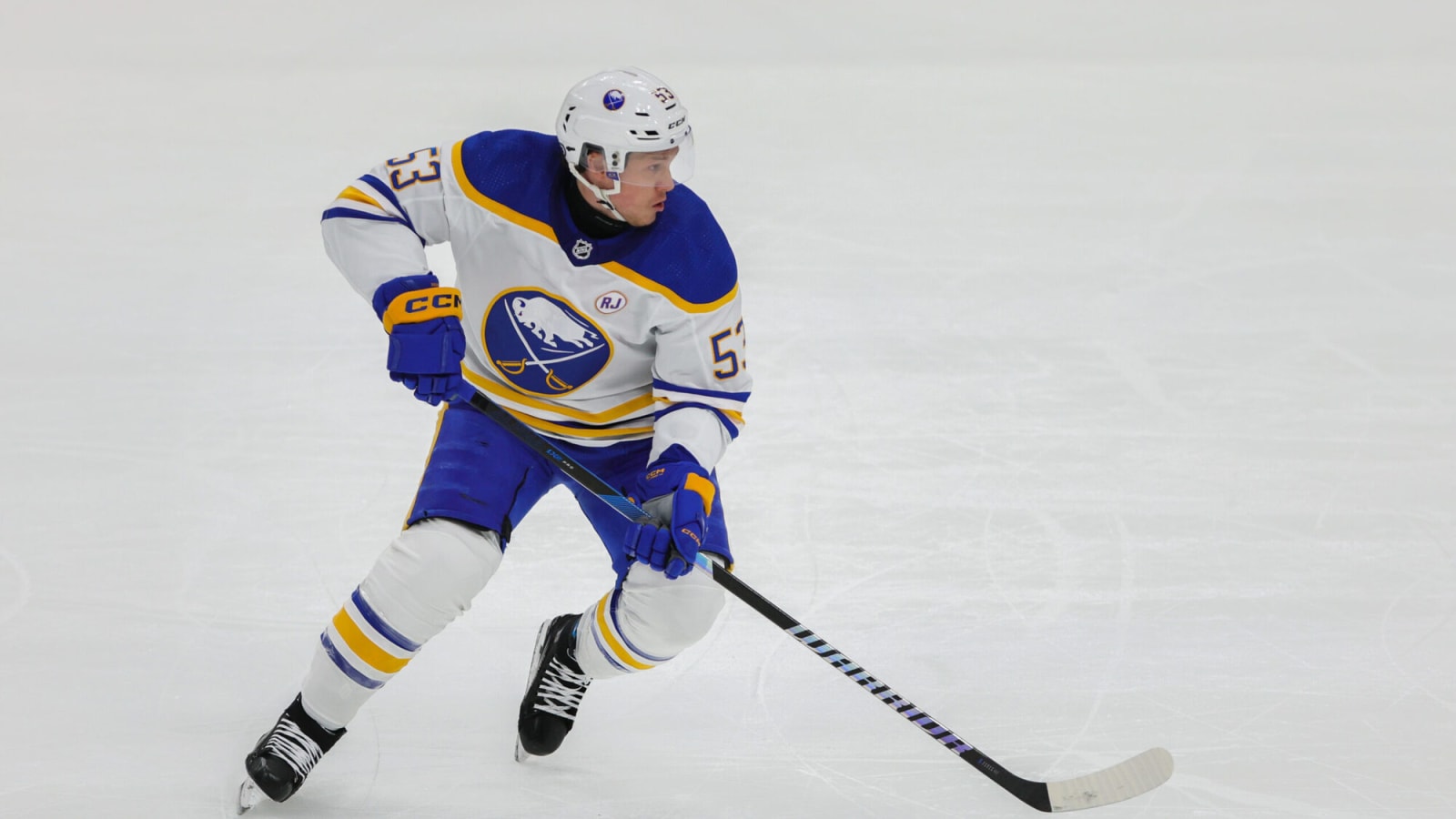
There should be little doubt that the Edmonton Oilers have been a fantastic offensive squad for quite some time. This past season, they ranked fourth in the NHL in total goals and third in goals at 5-on-5.
But what if I told you that this team had the potential to score significantly more?
In 2023-24, the Oilers scored 193 goals at 5-on-5, a pretty high number. But, based on the volume and quality of their shot attempts, they were expected to score 223 goals per EvolvingHockey’s expected goals model.
This high expected goals number isn’t exclusive to EvolvingHockey’s model. Natural Stat Trick’s model had the Oilers at 212 expected goals, while MoneyPuck had the team at 217 expected goals.
In fact, the Oilers have scored fewer goals than expected in the past three seasons per each of EvolvingHockey, Natural Stat Trick, and MoneyPuck’s models. Even sneak peeks at private models such as SportLogIQ – which use more granular data than public models – rank the Oilers higher in expected goals than actual goals.
So, what does all of this exactly mean?
The Oilers are the best team in the league at generating high-danger scoring chances – it’s not particularly close at all, whether you use public or proprietary models. But, these stats indicate that, based on the types of chances they are creating, there’s potential for even more goals with efficient finishing.
For years, the Edmonton Oilers have had plenty of volume scorers, players that don’t exactly have an elite shot but score a high amount of goals by consistently generating a high number of quality shot attempts. Zach Hyman is the textbook example of a volume scorer, as he generated a whopping 57 expected goals in 2023-24 and scored 54 goals. But, the team has not had a (sustainably) high efficiency finisher on Connor McDavid nor Leon Draisaitl’s wings.
However, that is a significant opportunity to change in 2024-25 with the signing of Jeff Skinner.
On July 1, the Oilers signed 32-year-old forward Jeff Skinner to a one-year contract at a three million AAV. The Buffalo Sabres bought out his previous contract, as his eight-year, $9M cap-hit proved to be too expensive, and the Oilers picked him up in free agency for a third of his former cap-hit.
Since the beginning of the 2021-22 season, Skinner has scored at a rate of 1.25 goals per hour at 5-on-5. Among all forwards who have played a minimum of 750 minutes in that span, that ranks 10th in the entire league, and it would rank first on the Oilers.
Since 2021, he has scored 68 even-strength goals on 55 expected goals—precisely the type of offensive player they needed.
Skinner was one of two top-six winger free-agent signings the Oilers made on July 1. The other winger was Viktor Arvidsson, who I analyzed in detail in an article yesterday.
In this piece, I would like to specifically focus on Skinner, how he could fit in Edmonton, and what he could bring to the team next season.
Firstly, here is a look at Skinner’s overall analytical profile:
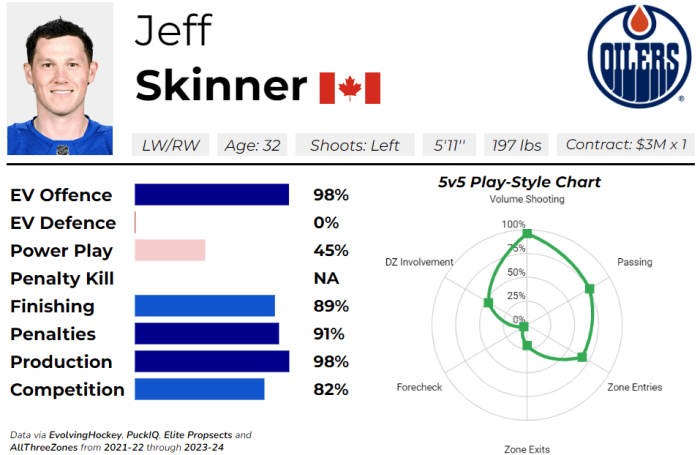
There are a couple of things to digest from this graphic. We’ll begin with the good.
McDavid and Draisaitl are the league leaders in assists in the past three seasons. Still, at 5-on-5, Draisaitl’s linemates have scored seven goals less than expected in that span, while McDavid’s linemates scored 17 goals less than expected. Those numbers are worse away from each other when they center their separate lines.
To clarify, I am not suggesting that the Oilers desperately needed more offence; my point is simply that both McDavid and Draisaitl’s play-making are just so good that there is potential for even more goals to be scored. Acquiring genuine finishing talent – like Skinner’s – could allow their passing abilities to be truly maximized.
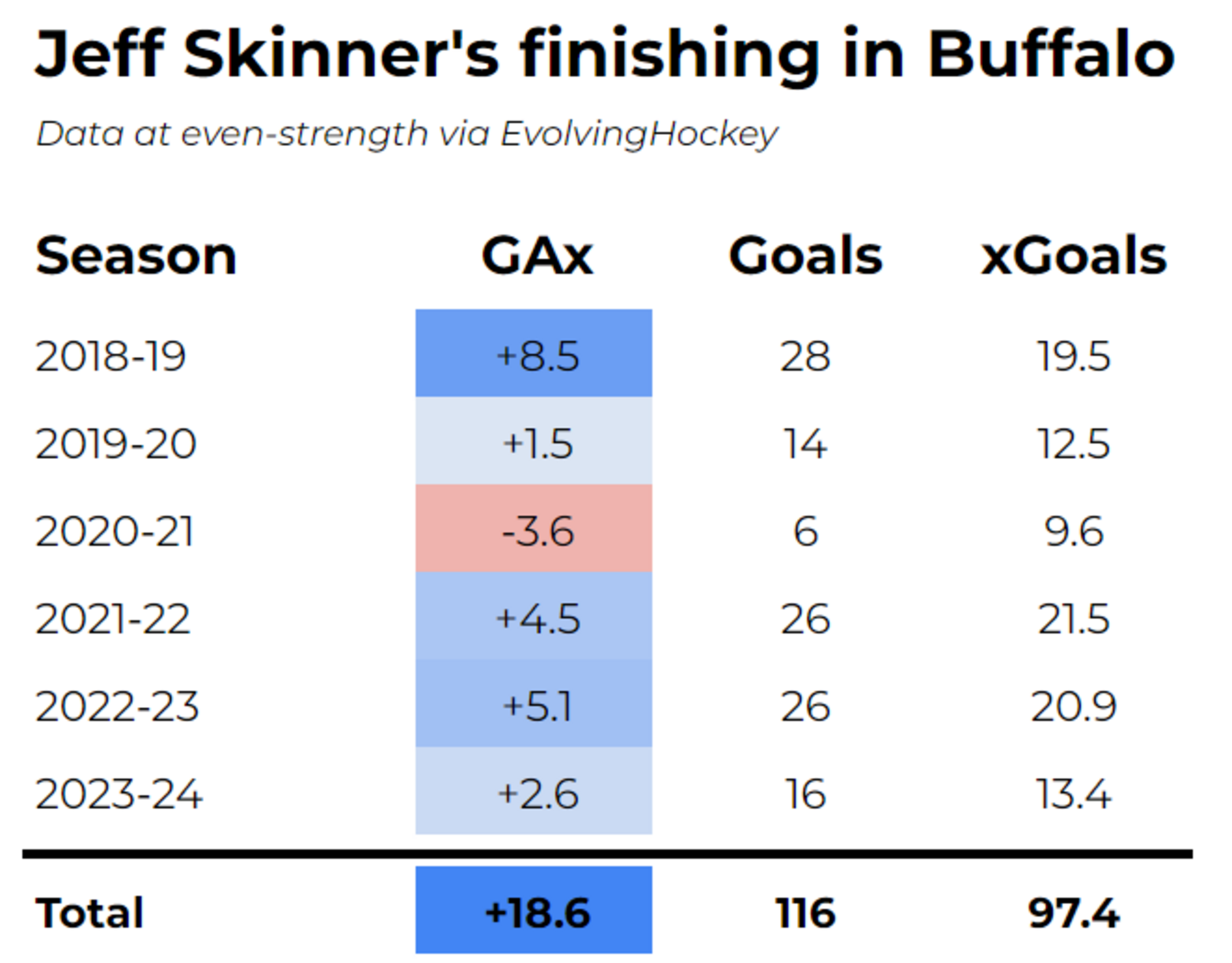
Skinner scored 40 goals in his first season in Buffalo, 28 of them at even-strength. He then had two mediocre years, scoring 14 and 7 goals in 19-20 and 20-21, respectively, but he’s back to a 32-goal pace in his past three seasons.
Overall, he has finished as a net positive in goals scored above expected in five of his six seasons in Buffalo. McDavid and Draisaitl are the only Oilers players to rank above Skinner in goals above expected in the past three seasons, at 5-on-5 and all strengths.
Skinner’s most valuable attribute to this team is his superb shooting abilities, as he can consistently capitalize on the chances he creates.
Even aside from his finishing, Skinner is simply an excellent offensive player. His passing abilities are pretty good, as his scoring chance assists per hour rate ranks in the 79th percentile among all forwards. At the same time, he additionally excels at generating shots off the rush.
I’ve seen some claims that his offence is inflated by the power play, and his total production may decline due to decreased PP time in Edmonton, but he is a fantastic offensive talent at 5-on-5.
Skinner’s overall impact on generating even-strength scoring chances (RAPM xGF/60) ranks in the 98th percentile among all forwards and 13th overall. He has produced at a rate of 2.6 points per hour at 5v5 in the past three seasons, which interestingly ranks first among all available UFA forwards this past July 1st.
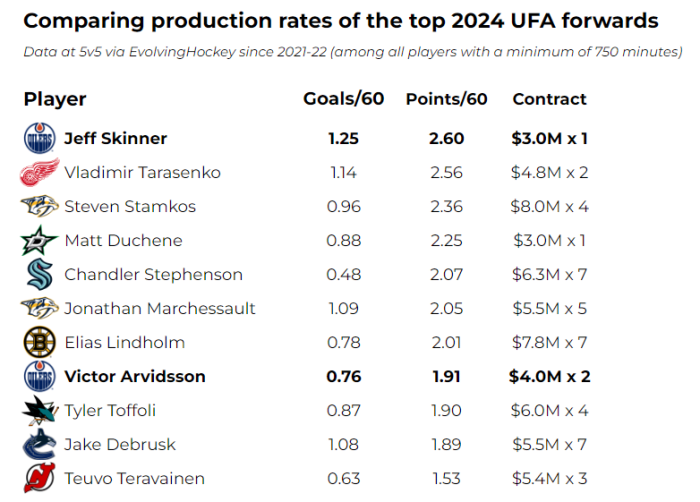
Both Skinner’s goal and point per hour rates rank higher than Steven Stamkos and Elias Lindholm, who signed contracts over $7.7M. Looking at this list, $3M is an extremely reasonable value for Skinner, and at just one year, there’s not much significant risk.
All-in-all, he is a tremendous overall offensive asset and the type that Edmonton can largely benefit from.
However, there are some downsides and risks to this player.
Some will immediately point out Skinner’s age, as he turns 33 next May and has seen a slight but noteworthy decline in his production from 2023-24 compared to the prior two seasons. Another downside, evident from the graphic above, is Skinner’s defensive play, which has been well below average for nearly the entirety of his career in Buffalo.
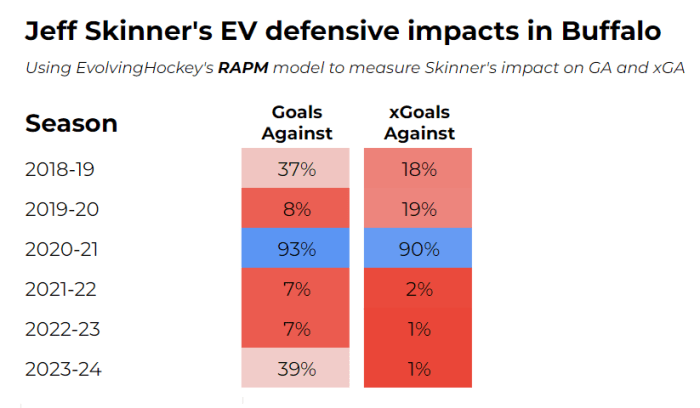
The stats above are calculated using EvolvingHockey’s RAPM model, which attempts to adjust a player’s metrics for factors such as teammates, competition, zone starts, etc.
Overall, Skinner’s defensive impacts are quite poor (2020-21 seems like a bizarre outlier in his career, and it’s probably safe to dismiss it). In particular, his impact on suppressing scoring chances has been horrific in the past three seasons. He’s a subpar forechecker, not very involved in his own end, and plays an overall high-event brand of hockey. Considering that the Oilers have not made any major defensive upgrades this off-season and just dealt their best 5v5 defensive bottom-six forward in Ryan McLeod, this is a fair point to bring up.
With that in mind, defensive metrics for forwards can often be volatile.
As mentioned above, models like EvolvingHockey’s do attempt to adjust each player’s metrics for the quality of their teammates, but the key word there is “attempt” – they are not perfect or objectively correct. Publicly, these models are the best tools to evaluate defensive ability, but they are certainly not flawless, particularly when adjusting a player’s metrics on a terrible team.
Notably, for wingers, these defensive impacts don’t always carry over on new teams, especially when there is an immense difference between the two teams’ defensive systems, as there is between Buffalo and Edmonton’s. This past season, the Oilers ranked 6th in the NHL in expected goals against per hour, while the Sabres ranked 25th. It’s worth mentioning that perhaps Skinner cheats for offence less on a much better team.
I’m not expecting Skinner to substantially improve into a positive-impact defensive player in Edmonton, but by moving from a non-playoff team to a cup contender, it’s fair to say his impacts will not rank at the very bottom of the league. I believe he will still rank below average defensively, but not outright horrendous. I don’t think that’s an unreasonable prediction.
Still, Edmonton should attempt to deploy him in a spot that would allow him to maximize his offensive strengths and hide his defensive deficiencies to the greatest extent possible. So, where could that be in their lineup?
First, let’s take a look at his results with Buffalo’s centers:
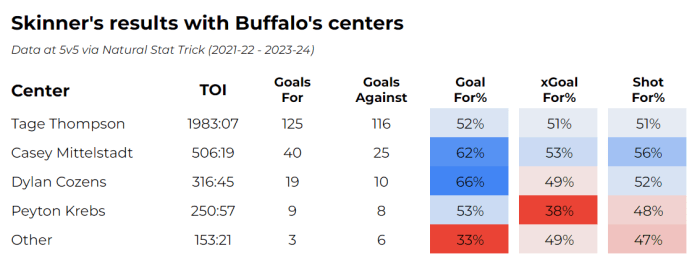
Skinner spent most of his time in Buffalo on Tage Thompson’s wing, who is not a great defensive center himself. Overall, their goal and expected goal percentages together are a net positive, but they were fairly high-event.
Skinner’s best two-way results came next to Casey Mittelstadt, a solid passer who was Buffalo’s best defensive center (before his trade to Colorado). Skinner was on ice for fewer goals, shots, and chances per hour playing on Mittelstadt’s wing, while his offensive rates even increased.
In my opinion, Skinner should not play next to Leon Draisaitl.
Draisaitl has improved defensively in recent years, but his impacts still rank well below-average (particularly due to how he can often have one or two stretches of very poor defensive play per season, such as December of 2019-20 as a notable example).
I’ve seen many project Skinner, Draisaitl, and Viktor Arvidsson as Edmonton’s second line. While that trio would be lethal offensively, especially off the rush, they could give up a lot of goals the other way. This is especially a potential concern considering that Edmonton has yet to fix their second defensive pairing, who would play the most minutes with the second line.
Instead, I believe Skinner’s ideal spot is on the top line next to Connor McDavid and Zach Hyman.
Now, I have seen some question whether Skinner can keep up with Edmonton’s top centers, as his foot speed has regressed. His speed bursts above 20 MPH per 60 ranked in the 6th percentile this past season, per NHL EDGE. Not a totally unreasonable notion considering he is 32, and those speed burst rates declined in 2023-24.
However, McDavid and Hyman have played well regardless of who is on their left-wing. Whether it’s Ryan Nugent-Hopkins, Adam Henrique, Warren Foegele, Evander Kane, Jesse Puljujarvi, and so on, that duo has controlled goals and chances by a massive margin (they are +67 in over 2000 minutes since 2021, while they hold an exceptional 61 percent expected goal share).
In my view, Skinner’s speed is not something to be overly concerned about if he is deployed correctly. McDavid and Hyman will be the primary offensive drivers and puck-carriers on the top line – all Skinner really needs to do is put pucks in the net.
By having both a volume scorer (Hyman) and a high efficiency finisher (Skinner) on McDavid’s wings, his play-making is fully maximized, which is what I love about this option. As McDavid has developed into a very responsible defensive center throughout the past four seasons, I believe the top-line is Skinner’s ideal spot.
However, Skinner could even be deployed on the third-line to balance the scoring. Think back to the 2016 Pittsburgh Penguins, who deployed Crosby, Malkin and Kessel on separate lines.
Of course, I don’t expect Skinner to be nearly as dominant as Kessel was, but I see it like this – if opposing teams try to hard-match their best players against McDavid or Draisaitl, their bottom-six will be forced to defend a third line with one of the league’s best 5v5 goal-scorers.
Skinner’s defence and foot speed would also be less of a concern playing weaker competition. At the very least, this is an option worth considering in my mind.
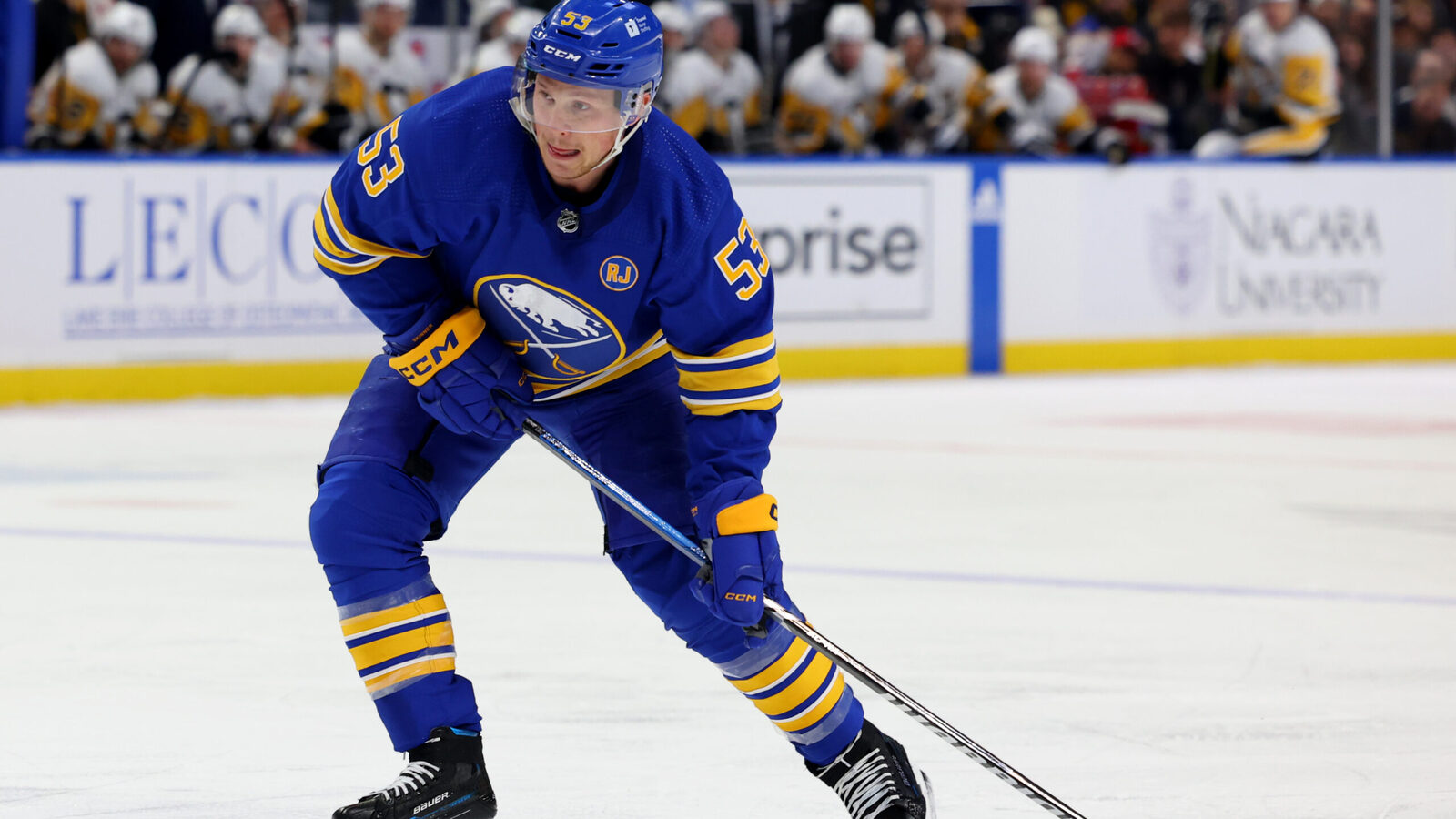
All-in-all, there are some risks and downsides to the Jeff Skinner signing, particularly his age, speed and defensive play. There is no guarantee he pans out and keeps up with Edmonton’s top centers.
But at just three million for one year, it’s a no-brainer to take the bet that he does pan out in Edmonton. It’s extremely fair value for a guy that has the potential to absolutely light it up on McDavid’s wing.
If he scores upwards of 25-30 goals – which is not unreasonable at all – he will be well worth his $3M cap-hit, even if his defensive results continue to rank poorly (and as I mentioned earlier, I believe they will see improvement in Edmonton).
A high efficiency finisher is precisely what Edmonton’s offensive core needed to maximize their offensive potential, and considering the contract, the risk is not too high at all. This is a smart signing by Jeff Jackson and Edmonton’s management, and I look forward to seeing how it will all work out in 2024-25.
*All stats used in this article via EvolvingHockey, Natural Stat Trick, and AllThreeZones unless mentioned otherwise
More must-reads:
- Rangers forward in a fight for his future amid new competition
- Maple Leafs make six roster cuts with two notable surprises
- The 'Multiple 30-TD pass NFL seasons' quiz
Breaking News
Trending News
Customize Your Newsletter
 +
+
Get the latest news and rumors, customized to your favorite sports and teams. Emailed daily. Always free!








